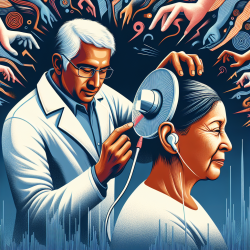The capacity to discern auditory signals amidst background noise is a critical aspect of effective communication and safety in various environments, particularly for individuals with hearing impairments. A groundbreaking research study titled "Choix d'une procédure de mesure de la capacité de détection d'un signal sonore dans le bruit en vue de la mise au point éventuelle d'un examen clinique" by Hung Tran Quoc, Raymand Hetu, and Chantal Laroche offers significant insights into measuring and enhancing this ability. This blog post delves into the practical applications of their findings for practitioners aiming to improve auditory signal detection in noisy settings.
The study critically evaluates existing methods for measuring frequency selectivity and proposes a novel approach using notched noise to predict an individual's capacity to detect auditory signals in ambient noise. This advancement holds promising implications for clinical settings, particularly in tailoring auditory warnings to the hearing capabilities of individuals with auditory deficiencies.
Understanding the Research
The research identifies three primary methods for assessing frequency selectivity:
- Psychoacoustic tuning curves
- Loudness summation
- Auditory filter measurements
Among these, the auditory filter measurements using notched noise were found to be the most valid and precise for predicting signal detection capabilities in noise. This method surpasses the limitations of psychoacoustic tuning curves and loudness summation, offering a more accurate and reliable means of assessing auditory filters.
Implications for Clinical Practice
The findings of this research are instrumental for clinicians and audiologists in several ways:
- Enhanced Diagnostic Tools: By integrating the notched noise method into clinical examinations, practitioners can more accurately diagnose and understand the extent of hearing impairments.
- Customized Hearing Aids and Assistive Devices: The precise measurement of auditory filters enables the customization of hearing aids and other assistive devices to match the specific frequency selectivity profiles of individuals, thereby improving their effectiveness.
- Workplace Safety: In industrial settings, the ability to tailor warning signals to the auditory capabilities of workers with hearing impairments can significantly enhance safety and prevent accidents.
- Research and Development: The study's methodology provides a foundation for further research into hearing impairments and the development of new technologies to aid those affected.
Encouraging Further Research
While the study marks a significant advancement in auditory signal detection measurement, it also highlights the need for ongoing research. Practitioners are encouraged to explore the implications of these findings in diverse settings and populations. Additionally, the development of more user-friendly and accessible clinical tools based on this research could further revolutionize the field.
Conclusion
The study by Tran Quoc, Hetu, and Laroche presents a pivotal step forward in our understanding and ability to measure auditory signal detection in noise. By adopting and building upon their methodology, practitioners can significantly enhance diagnostic accuracy, the effectiveness of hearing aids, and safety in noisy environments. As we continue to explore and refine these techniques, the potential to improve the lives of individuals with hearing impairments grows exponentially.
For those interested in delving deeper into the specifics of the research and its methodology, Choix d'une procédure de mesure de la capacité de détection d'un signal sonore dans le bruit en vue de la mise au point éventuelle d'un examen clinique offers a comprehensive exploration of this innovative approach.










